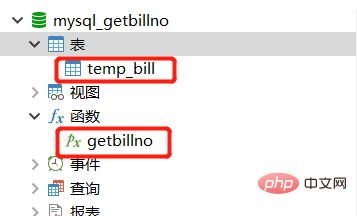
SQL server Version , now has "SQL server high concurrent generation of unique order number"
Recommended: "mysql tutorial"
一, Scene reproductionIn an ERP purchase-sales-inventory system or other systems such as 0A, if multiple people perform the operation of generating order numbers at the same time, it is easy for multiple people to obtain the same order number, which will affect the company's business. Causing irreparable losses2. How to avoid high concurrency situations where order numbers are not uniqueWe can use stored procedures and data tables to create a table and create a stored procedure. The stored procedure is responsible Generate order numbers, and the table is responsible for handling uniqueness issues

1. First create a stored procedure The input is BILL_TYPE (prefix) and the output is BILL_NOP (order number)
CREATE DEFINER = CURRENT_USER PROCEDURE `getbillno`(in BILL_TYPE VARCHAR(3), out BILL_NOP varchar(25))BEGIN
2. Generate the year, month, day and suffix The year, month and day is the current system time, and the initial value of the suffix is 0
DECLARE currentDate varCHAR (15);DECLARE lastno INT DEFAULT 0;SELECT DATE_FORMAT(NOW(), '%Y%m%d') INTO currentDate;
3. Query the table and obtain The order number of the table Query the table and get the latest order number with the prefix related to the custom content
SELECT IFNULL(BILL_NO, 'notnull') INTO BILL_NOP FROM temp_bill WHERE SUBSTRING(BILL_NO,1,3) =BILL_TYPE and SUBSTRING(BILL_NO,4,8) =currentDate ORDER BY BILL_NO DESC LIMIT 1;
4. Generate the order number
The generated order number is: UIE20200611016
Example: Generated order number: UIE20200611001
IF BILL_NOP !='' THEN SET lastno = CONVERT(SUBSTRING(BILL_NOP, -3), DECIMAL) ; SELECT CONCAT(BILL_TYPE,currentDate,LPAD((lastno + 1),3, '0')) INTO BILL_NOP ;ELSE SELECT CONCAT(BILL_TYPE,currentDate,LPAD((lastno + 1),3, '0')) INTO BILL_NOP ;END IF;
5. Insert the generated order number into the table If the same
order number exists in the table, the insertion into the table will fail If in the table If the same
order number does not exist, the insertion into the table is successfulINSERT INTO temp_bill (BILL_NO, BILL_TYPE) VALUES (BILL_NOP,BILL_TYPE) ;
When the order is inserted into the table successfully, the unique order number can be returned (if the above If one step is unsuccessful, this step will not be run)
SELECT BILL_NOP;
is:
UIE20200611001
2 When I enter it for the second time, because there is data in the table , the suffix of the latest order number will be 1
UIE20200611002
# 5. Summary that is not a summary
I hope this article can help everyoneIf you have enough points, just download it directly. If you don’t have points, just type on the picture. The amount of code is not big anywayIf you are a student and don’t have points, you can chat with me privately and I will send you the source code for free
Code download link: mysql_getbillno.sql
Code screenshot:
The above is the detailed content of MySQL high concurrency generates unique order numbers. For more information, please follow other related articles on the PHP Chinese website!




